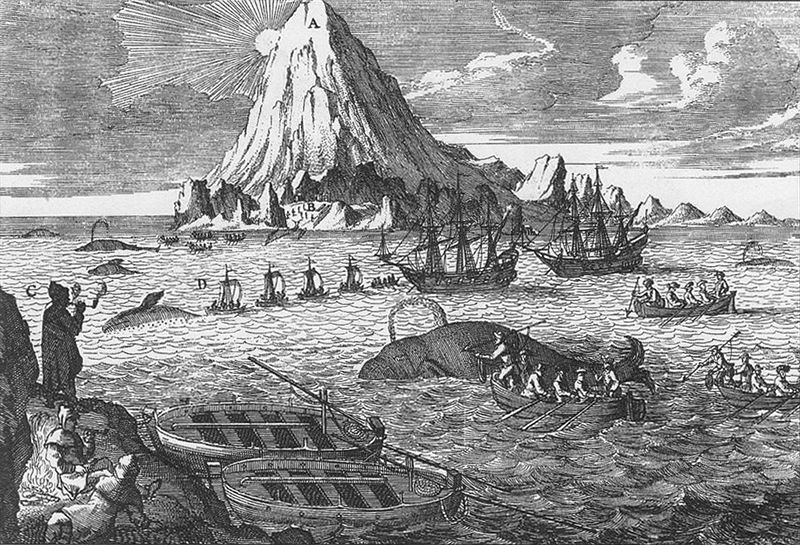Is ambergris whale vomit or whale poo?
Interview with
Author Christopher Kemp tells us about the mysterious substance that people have prized for centuries...
Sarah - Ambergris comes from the guts of sperm whales and for centuries people have found lumps of it lying on beaches and invented all sorts of uses for it, most famously in fragrances. And there are still big mysteries surrounding this peculiar stuff.
Christopher Kemp is a molecular biologist who's spent the last couple of years on the trail of ambergris - and his book Floating Gold, has just been published by University of Chicago Press.
For a natural compound known for its use in perfumes, the surprising thing Christopher found out during his research was just how difficult it is to describe the smell of ambergris.
Christopher Throughout history people have really struggled to adequately describe the smell of ambergris. I actually have a couple of pieces right here as I speak to you and they're both very different to one another. I've got one piece that's black and fresh. It's even a little sticky in my hand and it smells like sheep dung. It's just incredibly dungy. It's what an organic chemist of a perfumer would call Indolic. It's got lots of indols and scatols in.
One of the more compelling things about it as a subject is that once it's been expelled in the ocean by a whale it requires years and years, perhaps even several decades of floating around in the ocean, being photo oxidised, being worked on by the seawater to mature into the really valuable expensive stuff.
So I'm holding now a piece of white ambergris and it smells completely different. It smells much sweeter, much more pleasant, it's just not as in your face as the fresh stuff.
Sarah - And while writing his book, Christopher fell under the spell of some pieces of extremely expensive ambergris...
Christopher - If you had somehow captured the smell of the ocean it would smell exactly like this one piece in particular that I'm thinking about. It was so ozoney, it was so full of that smell of wide open spaces and seaweed and marine life that it was almost like a scratch and sniff ocean sticker. It really caught me off guard. I was so taken by it I almost offered to buy it on the spot and it was probably worth about $1000 and I was not in a position to spend $1000 on a piece of aged whale poop. It was just such a smell I just really didn't want to stop smelling it.
Sarah - The main use of ambergris today is as a fixative in the perfume industry for which the genuine article is still extremely highly valued- it's not only the smell of ambergris itself that is prized, but its ability to make other aromas last for longer on the skin, due to its extremely low volatility.
In the past ambergris has been used for all sorts of things. It was used as a cooking ingredient and as late as the 18th century people were using it as a medicine, prescribing it to treat everything from headaches to impotence, bruises and even as an anti-depressant.
Christopher - The one use that I was really tickled by was that it used to be worn as jewelry as well. People would carve it and make ornate jewelry out of it and it was the heat from a woman's body would warm up the ambergris and make it smell more.
Sarah - And all the while they've been using it people have also been inventing a host of ideas about where this stuff comes from:
Christopher - There were explanations that it was a meteor that had fallen from outer space. Other people said that it was the liver of a certain species of fish. Because ambergris often appeared on the shore after storms or periods of stormy weather, there were quite a few theories that it grew on the ocean floor and was dislodged by stormy seas.
So people thought it was a special type of mushroom or a fungus that grew there or a fruit like a pear that grew in the ocean. People thought that it was the sperm of whales or that it was honey that had been cured by salt water.
When you think about it, the truth sounds just as ridiculous as all the other theories. So it's not a surprise that some of it sounds so strange.

Sarah - The truth about the source of ambergris was only revealed with the development of the whaling industry. As people started killing more and more whales, it became clear that ambergris comes from inside sperm whales.
The most detailed analysis of how exactly ambergris forms was written by whale scientist, Robert Clark, who passed away last year. A bit like when seashells make pearls to deal with irritating bits of sand and grit, it seems that when the sharp, indigestible beaks of squid irritate a sperm whale's guts they trigger production of a cholesterol-rich secretion that binds the beaks together into a smooth, solid lump.
So, mystery solved! Perhaps... but still some confusion remains about which end that lump comes out - is ambergris whale vomit, or whale poo?
Christopher - If someone stumbles on a piece of ambergris somewhere you'll get some headline in the newspaper like "Whale coughs up a jackpot" or "Moby Sick makes man rich". And so there is still this confusion about whether its regurgitated or whether its expelled and pooped out. But you can talk about whether its just like a hairball, because that's another thing you come across time and again. But its not because hairballs don't smell like poop.
Sarah - The key component that's responsible for the unique nature of ambergris is a molecule called ambrein.

Christopher - It's the building block that gives rise to all the other aromatic compounds that are found in ambergris. And ironically its odourless. It's a very nondescript little molecular compound. It basically overtime in the ocean breaks down to produce this bouquet of other aromatic compounds that all smell of different things and that's why people smell these certain things like tobacco and mould and seawater.
So the journey is from ambrein to a substance called ambergris oxide, which is the one thing that smells exactly like ambergris, that doesn't smell like anything else and nothing else really smells like.
It's that ambergris oxide, or naptho-furan that chemists have copied to make synthetic ambergris, but as Christopher says, it's not really the same...
Christopher - It's like comparing an original Van Gogh to a print of Van Gogh. They certainly have the same molecular composition but there's something lacking. There's something that cannot be recreated in the lab.
Sarah - In his book, Christopher tells many stories of people finding objects washed up on a beach and believing they've found their fortune in a lump of ambergris - sometimes they're right but often they've been wrong. He spent a long time himself on a quest to find his own piece of valuable flotsam. So how do you know if you've found the genuine article? Well, it's not that straight forwards. We already know it can have various different smells, but it also comes in various shapes and colours:
Christopher - It can be anything from black like a little piece of coal, to white and pitted like a piece of pumice, and any colour in between really. And it just has to look like nothing else on the shoreline. That's the best way to try and find it. So basically it's a process of elimination, if you can say well that's definitely some rotting seaweed, or that's definitely a piece of driftwood or a dead seagull, then you know that's not ambergris but otherwise there's an enormous range of things that could be ambergris.
Sarah - To help narrow things down there are a couple of simple tests that can help identify ambergris.
Christopher - It's slightly less dense than water and so it floats on the surface but not quite on the surface. It's almost like an iceberg in that part of it would bob above the surface but most of it would be below. So you have to make sure that it floats a little bit. If it feels heavy like a stone then it's not ambergris. The other traditional test, even if you go back to 1720 and read articles that were written then this is the test they tell you to do then, it's the test now - the hot needle test. Where you heat up a needle or a safety pin or something like that until it's really hot. And then you take your suspected piece of ambergris and you poke it with the hot needle. If it's ambergris then it would melt into a chocolate brown liquid and give off a real aroma and there would be a little bit of smoke because it's highly flammable. And that's really traditionally the sure-fire way of making sure you've got ambergris.
But there are plenty of things that float in the ocean that would react like that to a hot needle and that's where people get into a lot of trouble.
These days, the things that are most often mistaken for ambergris are actually manmade products that were manufactured by some industrial process and have been dumped into the ocean either on purpose or by accident. And then floated there for decades until they're no longer really recognisable. So often people will find these really weird shapes that obviously were plastic or something like that and they melt really readily when you poke them with a hot needle.
And so that's something that used to be a great test maybe 2-300 years ago when there were fewer things that react the way that ambergris does but these days I think you could walk along almost any beach after a really violent storm and you could find things that have been manmade in some factory that melt into a chocolate brown liquid.
Find out more:
Floating Gold, Christopher Kemp, Chicago University Press









Comments
Ambergris
Would it be reasonable to say that Ambergris acts as a "sponge" for other odors in the ocean? I say this based on the understanding that Ambrein is odorless until oxidization.
Thank you for any assistance you can provide.
Ambergris
That is the first time that I reading an article that says
Ambergris is whale vomit
All the books on Perfumery clearly describe this as
Whale excreta, produced in the gut/intestines after
irritation
Can someone explain further ??
Thanks
It's probably both...
From Wikipedia: "Ambergris is usually passed in the faecal matter. It is speculated that an ambergris mass too large to be passed through the intestines is expelled via the mouth, leading to the reputation of ambergris as primarily coming from whale vomit."
Add a comment